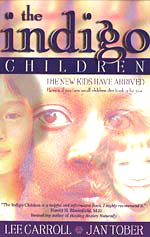|


by
Lee Carroll and
Jan Tober
from
GreatDreams Website
What is an Indigo Child? And
why do we call them Indigo?
First, the definition:
 An Indigo child is one who displays a new and unusual set of
psychological attributes and shows a pattern of behavior generally
undocumented before. This pattern has common unique factors that
suggest that those who interact with them (parents, in particular)
change their treatment and upbringing of them in order to achieve
balance. To ignore these new patterns is to potentially create
imbalance and frustration in the mind of this precious new life. The
subject of this chapter is to identify, qualify, and validate the
attributes of an Indigo Child. An Indigo child is one who displays a new and unusual set of
psychological attributes and shows a pattern of behavior generally
undocumented before. This pattern has common unique factors that
suggest that those who interact with them (parents, in particular)
change their treatment and upbringing of them in order to achieve
balance. To ignore these new patterns is to potentially create
imbalance and frustration in the mind of this precious new life. The
subject of this chapter is to identify, qualify, and validate the
attributes of an Indigo Child.
There seems to be several kinds of Indigos, and we will describe
them later in this chapter, but in the following list we can give
you some of the most common behavioral patterns. Do these fit anyone
you know?
The ten most common traits of Indigo Children:
1. They come into the world with a feeling of royalty (and often act
like it).
2. They have a feeling of "deserving to be here," and are surprised
when others donít share that.
3. Self-worth is not a big issue. They often tell the parents "who
they are."
4. They have difficulty with absolute authority (authority without
explanation or choice).
5. They simply will not do certain things; for example - waiting in
line is difficult for them.
6. They get frustrated with systems that are ritual-oriented and
donít require creative thought.
7. They often see better ways of doing things, both at home and at
school, which makes them seem like "system busters" - (nonconforming
to any system).
8. They seem antisocial unless they are with their own kind. If
there are no others of like consciousness around them, they often
let no other human understand them. School is extremely difficult
for them socially.
9. They will not respond to "guilt" discipline - ("Wait till you
father gets home and finds out what you did").
10. They are not shy in letting you know what they need.
Why are these children called Indigo?
Throughout the history of psychology, there have been systems of
grouping human behavior. Indeed, often we all seem to fall into
"clumps" of behavior patterns, sometimes fun to read about and
identify with. These groupings try to identify and correlate human
actions in many different ways - undoubtedly searching for some
formula that neatly fits everyone into a slot of some kind, helping
those who deal with the study of the human mind. Some of these
systems are ancient; some are very new.
Validation of this fact is made by Richard Seigle, M.D., a
practicing psychiatrist who is also very involved in human and
spiritual studies within the
Navajo Indian Nation.
Dr. Seigleís input:
Throughout the history of Western civilization, we have had a strong
need to explore, define and judge. As we discover new lands and
peoples on Earth, our first thoughts were: "Who is like us and who
is not. And what can we take?" Those people who were not like us in
terms of color, belief, culture, and language were considered
inferior throughout much of our history.
In scientific terms, we tried to categorize people by the shape of
their heads, skin color, IQ, and so on. Anthropologists and
psychologists have spent years evaluating how we think feel, and
act. Here are some examples of various categorization systems:
-
Intelligence tests, such as Wechsler (WAIS) and Stanford-Binet
Personality
-
Personality tests such as MMPI, MCMI, Type A, and Type B
-
Projective personality assessments, such as Rorschach, TAT, and SCT
-
Memory tests, such as WMS and Bender
Specific psychological factors
Factors such as the following have
sometimes been used as a basis for grouping human behavior; family
structure and customs; culture; dreams; self-psychology; bonding and
attachment; myths; religion; conscious and unconscious motivation
and thoughts.
Recognized psychiatric theorists such as the following used various
systems of personality typing: Freud, Jung, Adler, Berne, Fromm,
Kernberg, Klein, Maslow, Peris, Reich, Rogers, Skinner, and
Sullivan.
Gandhi said,
"Our ability to reach unity in diversity will be the
beauty and test of our civilization."
The end of this millennium
signals a higher consciousness of love and acceptance of all people
- something that we could have learned centuries ago from the native
cultures, if only we hadnít perceived them as inferior.
Besides the traditional ones, there are also the
spiritual and
metaphysical grouping systems, which try to classify humans based
on, for example, their birth attributes (astrology), their life
energy, or their sacred animal association (Chinese and American
Indian roots). Whatever you think of astrology and some of these
seemingly unscientific systems, they have been recognized and
identified institutionally as some of oldest sciences, having been
found in many of the most ancient texts of human studies.
All of
these systems, ancient and current, exist to help humans better
understand humans.
|
